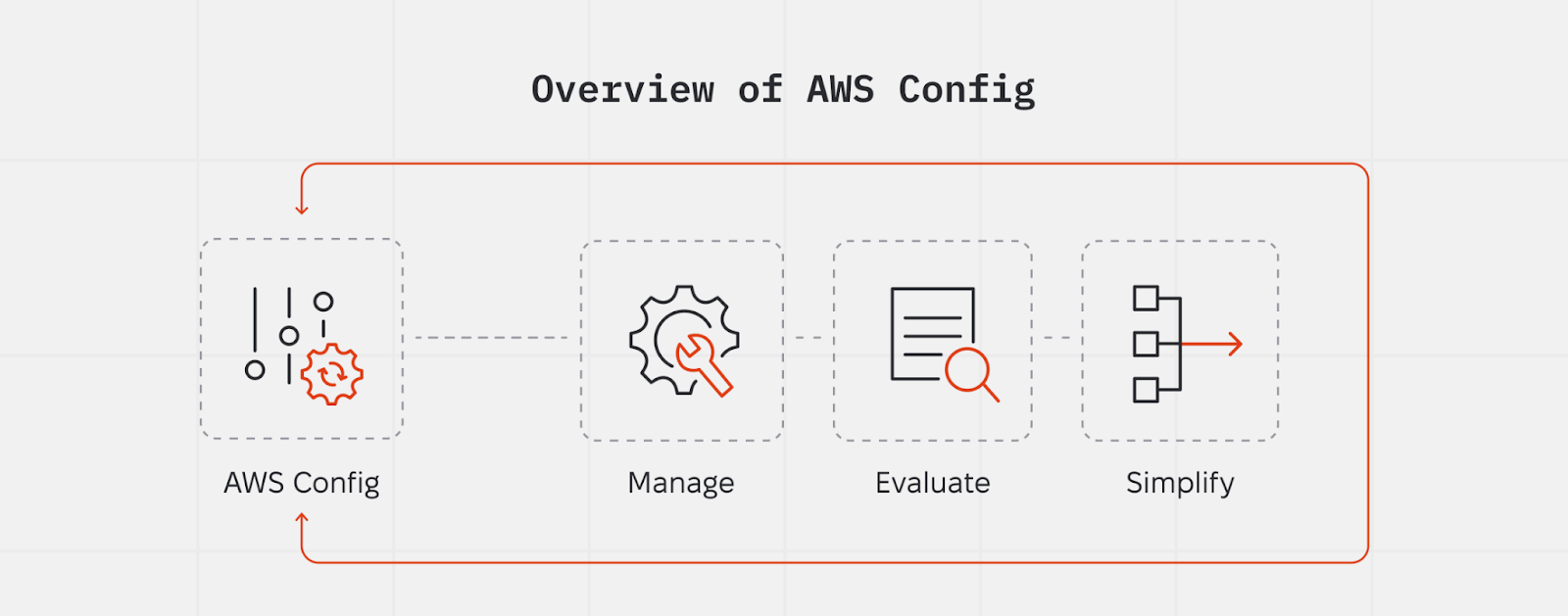Hi, I’m Arsen Yushchenko, a System Engineer at MEV.
Over the years, I’ve faced the challenge of ensuring infrastructure meets strict regulatory requirements like HIPAA. Manual audits made this worse – slow, resource-heavy, and full of room for error.
AWS Config turned this process around. It takes the pain out of compliance monitoring, gives you real-time insights into your infrastructure, and makes reporting effortless. Today, I’ll show you how AWS Config can save you time, money, and stress as your business scales.
Overview of AWS Config

AWS Config is your infrastructure watchdog.
It tracks, records, and displays how your AWS resources are configured. It shows how resources are connected, how they’ve changed over time, and whether they meet compliance requirements.
If you’re managing multiple accounts or navigating strict regulations, AWS Config simplifies operations and puts you back in control.

What Does AWS Config Do?
AWS Config tackles the critical challenges of managing cloud infrastructure:
- Resource Administration: Continuously check if your resources meet predefined rules. Non-compliant resources? AWS Config flags them immediately.
- Auditing and Compliance: Get a detailed history of resource configurations to prove compliance when it matters most.
- Managing and Troubleshooting: Quickly track down what caused an issue and restore stable configurations with confidence.
- Security Analysis: Spot vulnerabilities by reviewing permissions and resource access settings.
It’s everything you need to keep your infrastructure aligned, secure, and efficient.
How AWS Config Solves Real Problems
If managing cloud infrastructure feels like a constant uphill battle – whether it’s staying compliant, fixing issues, or making sense of a sprawling multi-region setup – AWS Config can fix that. It’s built to save you time, cut costs, and keep your business running smoothly.
Configuration Recording
AWS Config records every configuration change, giving you a full timeline of your resources.
It integrates with AWS CloudTrail, showing exactly who made changes, when they happened, and how they affected your system.
- Why it matters: When something breaks, you don’t waste hours guessing. AWS Config pinpoints the root cause in seconds.
- Cost control: For cost savings, choose between:
- Continuous Recording: Track changes in real-time.
- Daily Recording: Log changes every 24 hours, which can reduce costs.
For example, switching to daily recording saved a client significant costs while maintaining full compliance across a dynamic EC2 fleet.
Managed and Custom Rules
Rules are AWS Config’s secret weapon. They ensure compliance without adding complexity.
- Managed Rules: Prebuilt for industry standards like HIPAA, PCI-DSS, and CIS.
- Custom Rules: Tailored rules using Lambda or CloudFormation Guard (CF Guard) for unique business needs.
Why it’s powerful: CF Guard eliminates the headache of managing numerous Lambda functions, making custom compliance scalable and easier to maintain.
Compliance can become a nightmare without automated rules - teams waste hours manually checking configurations, risking missed issues and non-compliance fines. AWS Config handles these checks for you, flagging problems in real time.
What to keep in mind: While AWS Config is incredibly powerful, its documentation lacks advanced examples, making it challenging to implement more complex custom rules. However, foundational resources like “Create AWS Config Custom Rules Using CF Guard Policies” and “Creating AWS Config Custom Policy Rules” can help you get started.
Querying and Inventory Management
AWS Config makes resource management simple with its centralized inventory and advanced querying tools. Whether you’re managing a single region or a multi-account, multi-region setup, it provides clarity and actionable insights to help you optimize your infrastructure.
How It Works
As shown in the screenshot below, AWS Config offers a set of predefined queries to analyze your resource inventory quickly. You can customize these queries to suit your specific organizational needs or write new ones from scratch.

Example: Let’s say you want to count all EC2 instances by type.
SELECT
configuration.instanceType,
COUNT(*)
WHERE
resourceType = 'AWS::EC2::Instance'
GROUP BY
configuration.instanceTypeThis query shows exactly how many instances of each type you’re running.
Why it matters:
- Identify underutilized resources.
- Cut unnecessary costs.
- Plan for future scalability with real data.
Natural Language Query Processor: AWS Config makes this even easier. Just type, “Find all stopped EC2 instances grouped by type,” and AWS Config generates the query for you. Once the query runs, you get clear, actionable output to make smarter decisions.
Output and Insights
Once you run the query, AWS Config provides a clear, downloadable output (as shown in the final image). This level of granularity empowers you to make smarter decisions, improve operational efficiency, and ensure your infrastructure aligns with your business goals.



Multi-Account and Multi-Region Support
AWS Config Aggregator simplifies compliance management across multiple AWS accounts and regions by providing a centralized view of your infrastructure. No more jumping between dashboards – everything you need is in one place.
The Compliance Dashboard (shown below) gives you:
- A Compliance Summary by Resources, showing the ratio of compliant vs. non-compliant resources in a clear pie chart.
- Insights into the Top 10 Resource Types by Non-Compliant Resources, helping you focus your efforts where they matter most.

The dashboard highlights compliance status at a glance, making it easy to act on non-compliant resources.
Why It Matters:
- Efficiency: Quickly filter resources by type, region, or tags to locate compliance issues in seconds.
- Clarity: Use the visual summaries to prioritize fixes and streamline audits.
- Control: Manage compliance across regions and accounts without the hassle of switching views.
For example, I’ve used AWS Config Aggregator to track compliance across several AWS regions. It helped identify non-compliant resources like EC2 Security Groups and RDS instances in minutes – something that would have taken hours manually.
AWS Config Aggregator ensures you stay proactive, consistent, and in control, no matter how complex your setup.
The Bottom Line
AWS Config eliminates the guesswork. It automates compliance, reduces risks, and streamlines your cloud management – so you can focus on what matters: growing your business. Whether you're tackling audits or scaling across regions, AWS Config ensures you’re operating smarter, not harder.
In the following article, we’ll walk you through the steps of setting up AWS Config. Let’s get you started.







.png)

.webp)








